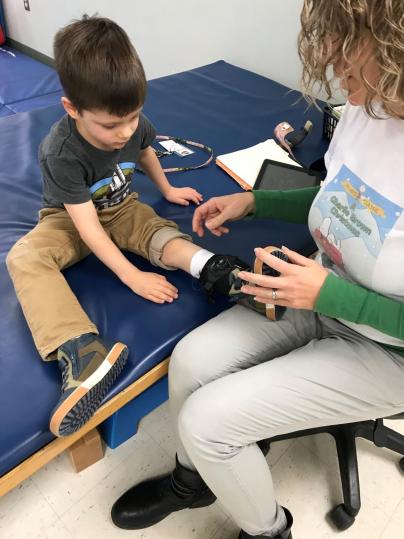First steps on a journey of recovery
December 18, 2019Four-year-old Jack Teyssier works through a series of exercises each week at Schreiber. His physical therapy sessions include strengthening and stretching for his lower left leg, some core work and some myofascial release by Schreiber therapist Lisa Stachler-Volk.

Jack Teyssier, 4, finishes his physical therapy session with Schreiber PT Lisa Stachler-Volk.
It’s hard to tell what exactly Jack is dealing with until Lisa puts some kind of black brace-like device on Jack’s left ankle.
Jack has one of the rare disorders therapists at Schreiber see from time to time. In this case, he has myofibromatosis, a condition that causes benign tumors to grow anywhere in the body.
According to the National Organization for Rare Disorders, most cases occur in young children and there can be a familial link. Jack’s mother Kara Teyssier said she had them on her leg and back; they were surgically removed when she was a baby. Her youngest son, Levi, also had one inside his cheek that was treated through chemotherapy and surgery.
It hasn’t been so simple with Jack.
“He has quite the medical history,” Kara said.
While Jack did his exercises with Lisa, Kara went through the list of Jack’s issues.
When he was born, he was diagnosed with pyloric atresia, an obstruction in the part of the stomach that leads to the small intestine. Doctors at Children’s Hospital of Philadelphia repaired that through surgery, and they also found the first his benign tumors.
At one month, Kara said she and her husband, Ben, noticed Jack’s left foot was droopy. Another of these tumors had developed and was pressing on a nerve in his leg.
So Jack went through a course of chemotherapy, and Kara said most of the tumors have shrunk or disappeared. But the one in his leg had caused permanent damage to the nerve. and Jack had lost the ability to flex his foot normally.
From the time Jack was 7 or 8 months old, Schreiber therapists began working with him at home. That lasted about a year and a half, until the Teyssiers decided he was doing well enough with a brace on his left leg.
Over time, though, his doctors wanted to try and restore more flexibility in his foot. They recommended another surgery, this time to take a tendon from the bottom of his droopy left foot and move it to the top of the same foot.
That surgery happened in March 2019, and he started coming to Schreiber for physical therapy in April.
Lisa has worked on helping him walk better. Before the surgery, the brace kept his foot in a neutral position to help him walk. But he couldn’t flex his foot at all.
“The surgery helped,” Lisa said. “He couldn’t lift his foot at all when we started. Now, he can keep his foot in a neutral (not drooping) position without the brace.”
She has been working on improving the strength of his left leg; his foot tended to roll and he would walk on the side of his foot. He’s also better able to flex his foot up and down. How far he will eventually progress isn’t known.
He can run around and play just like any other 4 year old. He rides a bike without training wheels. When he walks, you can’t even tell he has any kind of a problem, Kara said.
“We have been pleased with his progress,” Kara said. “At home, he doesn’t even wear the brace a lot of the time. Long term, we don’t know if he’ll have to keep the brace. Time will tell what happens as he continues to grow and get stronger. We’re blown away with how far he’s come.”